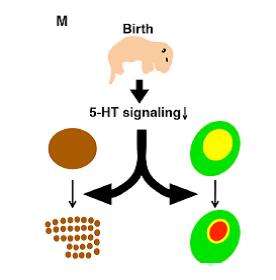Cerebral sensory development: Genetic programming versus environmental stimuli

Hiroshi Kawasaki and colleagues at Kanazawa University, Tokyo University, Tokyo Institute of Technology and Kumamoto University in Japan have identified how sensory map development is regulated in mice pups at birth, and the molecular signalling responsible.
The part of the brain associated with the sense of touch – the somatosensory cerebral cortex – has attracted numerous studies aimed at determining the influence of extrinsic environmental and intrinsic genetic factors in sensory development. Understanding the role of these factors in sensory map formation and development may provide insights into the mechanisms behind other circuits in the central nervous system. Now Hiroshi Kawasaki and colleagues at Kanazawa University, Tokyo University, Tokyo Institute of Technology and Kumamoto University in Japan have identified how sensory map development is regulated in mice pups at birth, and the molecular signalling responsible.
Rodents have a sensory map in the primary somatosensory cerebral cortex, characterized by cell clusters called barrels filled with patches of nerve fibre. Inputs from the part of the brain that link to the rodent's whiskers terminate at these barrels. The barrel distribution pattern is the same as the distribution of the whiskers on the snout and forms soon after birth.
The researchers induced preterm birth in mice and quantitatively compared the degree of development of whisker-related barrel pattern formation with mice born after the full term of pregnancy. At set periods after conception, barrel formation was significantly more advanced in the mice born preterm. Further experiments ruled out the role of maternal hormones prior to birth and identified the critical effect of serotonin reductions during the days after birth.
"Interestingly, the regulatory mechanisms described here were also found to regulate eye-specific segregation in the visual system, raising the possibility that they are utilized in various brain regions," the researchers suggest. They add that further investigation of the range of roles of serotonin and the underlying mechanisms will be interesting for future research.
More information: "Birth Regulates the Initiation of Sensory Map Formation through Serotonin Signaling." Tomohisa Toda, Daigo Homma, Hirofumi Tokuoka, Itaru Hayakawa, Yukihiko Sugimoto, Hiroshi Ichinose, Hiroshi Kawasaki. Developmental Cell - 14 October 2013 (Vol. 27, Issue 1, pp. 32-46). DOI: 10.1016/j.devcel.2013.09.002
Journal information: Developmental Cell
Provided by Kanazawa University




















